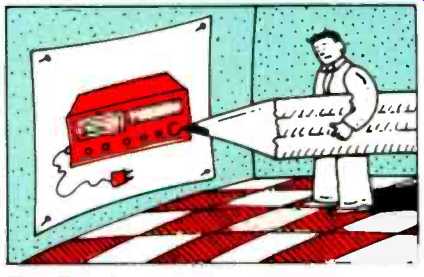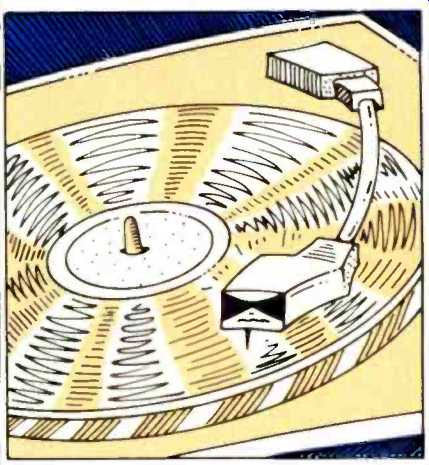Bit Buckets and Bit Streams

The CD-ROM format standard for computer data on Compact Discs was issued quite some time ago. So far, however, not much computer data is available on CD-ROM, and few manufacturers can yet supply CD-ROM drives.
That could change quickly this year. Microsoft, a major computer software company, is holding a conference to set CD-ROM file standards, necessary because computers don't access CD data the way we listeners do. When we listen to music, we dip our ears in a running stream, concentrating on the information reaching us right now.
What's past has been processed and partially forgotten, background to the notes of the moment; what's yet to come can only be anticipated.
Computers don't just take a dip; they imbibe data by the bucketful and store it in memory, where any part of it can be accessed instantly.
What's in the bucket matters a great deal. Each dip into the bit stream should yield a precisely defined block of bits, a file, containing only the program or data the computer needs to work with. This involves not only reading a track index, as musical CD players do, but checking for precise sequences of bits that define exactly where each file begins and ends. Otherwise, the computer might find parts of an adventure game where it expected instructions on filling out an income tax return. Citing destruction of an enemy asteroid as a capital loss is sure to earn you an audit.
Computer files on tape and floppy disk already include such file markers, but the markers vary according to the computer and the operating-system program it uses. Of the five Radio Shack TRS-80 operating systems I have at home, for example, only two can read each other's files, and none can read those of my wife's Kaypro. Such incompatibilities are barely tolerable for the comparatively small production runs that are economical with magnetic media. The high cost of CD mastering, however, restricts CD's use to discs with some potential for widespread sale. Otherwise the cost per disc becomes prohibitive. If separate masters were needed for Tandy, Apple, IBM, and Commodore editions, CD-ROM would be uneconomical. However, if a common file standard can be used, then all computers will be able to read the same discs, and the potential market for each disc becomes more promising.
We'll probably never achieve full interchangeability of discs among computers. Files of reference information--such as catalogs, interactive novels, encyclopedias and back issues of Audio--can be made universal. Programs, which tell computers how to use information or perform other tasks, cannot, because the computers speak entirely different languages. It would be like giving a Martian directions in Swahili.
So far, this all has little to do with sound and music. Computers are riding on the coattails of a medium developed for us, and so far contributing little to it. Once CD-ROM takes off, however, computer use will be the driving impetus towards developing low-cost equipment to record CDs. Judging from our mail, there's a substantial audiophile demand for it.
Pocket Karaoke

A recent visit to an electronics trade fair in Taiwan turned up very little audio equipment (even Proton was displaying mostly video). But I was intrigued by a pocket-sized karaoke unit from a company called Tranbon. (At least I think it was one unit-the Chinese-language brochure showed it labeled the "Go Singer," while the English-language flyer showed it as the "Sing Along"; both versions were model TE-202.) The unit has two microphone inputs, two earphone/speaker jacks, and a signal input (presumably preamp level). A signal is fed in from a tape recorder and mixed with the signals from the microphones; the mixture is fed back to the singers via the headphones or can be fed to an external speaker "for public amusement." The voices are enriched by an echo circuit-a feature no karaoke outfit can do without.
The TE-202 is good for more than karaoke. It can be used as an intercom between a motorcycle rider and passenger, as a mixer when you sing along with an electric musical instrument or, in karaoke configuration again, for learning a language via lessons on tape.
Sealed-In Goodness
Before audiophiles turned their attention to capacitors, resistors used to be a talking point. I remember replacing the noisy carbon resistors in my first tape deck's signal path with quieter metal-film ones. (Like most of us, I never measured the difference, but took the improvement on faith.) Now I've just heard, for the first time, of a resistor which might have audiophile applications-hermetically sealed thin-film resistors. According to Electronic Design, the John Fluke 8842A digital multi-meter uses these resistors in critical circuits to maintain accuracy for two years between re-calibrations. I wonder if we'll see such sealed resistors in perfectionist audio equipment soon-or if some audiophile manufacturer is quietly using them already.
The Breaks

I once got into an argument with a tape-deck designer when I suggested that he should have put the tape-break detector switch on the opposite side of the head assembly. "You can't!" he snapped. "There's no room there!" Then we looked behind the panel and discovered that he'd placed the tape-break switch in the most crowded location possible, while my suggestion would have made assembly much easier.
It was too late to change the design at that point (it usually is, by the time we journalists see a new product).
But that may have been all to the good, since his placement of the switch made at least as much sense as mine. He'd placed it between the capstan and the take-up reel, where it would detect all tape breaks but would also prevent using the recorder to spool unwanted sections of a tape into the wastebasket while editing.
Since I did a lot of live recording at the time, I wanted the switch between the head assembly and the feed reel; there, it would allow such editing but would miss any tape breaks that occurred after the tape had passed the capstan. A better compromise might have been to leave the switch where it was, but have some means of bypassing it or latching it in its "tape-unbroken" position.
The point of all this is that when you look at some aspect of an audio component's design and wonder why the designers failed to do something as you would have, think again. You may be right in assuming that your way is logical, but you may be wrong if you assume the designer acted unwisely.
Having a different mind, different experience, and different prejudices than the designer, you are bound to come up designer did not use. But the designer had to juggle factors you may not be aware of. Production cost is a major example.
It's no good designing in a nice touch that will attract 1,000 more purchasers if that raises the price sufficiently to drive away 2,000 others.
Space availability must be considered too, especially in car stereo. For a given panel space, the designer must choose between having fewer large controls and more numerous tiny (and crowded) ones. Circuit functions must also be considered. If placing a control where it's most logical will involve a long and noisy signal path, which should be compromised ergonomics or performance? How will the product be used? Assumptions about this will bear heavily on the ultimate design. Will this tuner be used in the city or the country? Will this recorder be used to tape music, speech. or both? How portable. how compact, must this piece of equipment be? What kind of light will it be used in? The designer does not have all the answers. That's why you and I can come up with ideas for ostensibly improving their designs. But we don't have all the answers either.
Needless Needling

When a stylus goes, it's often the whole cartridge that's replaced. One reason is that there's more competition to sell cartridges than styli, so cartridges are more heavily discounted and easier to find. A more fiendish reason is that cartridge makers often hide the cartridge and stylus numbers where you can't find them unless you remove the cartridge from the arm's headshell. Even then, you can't always find them.
Makers who offer multiple stylus options temper their helpfulness by making it impossible to tell your 78-rpm stylus from your micro-shibatalliptical without looking up the number or color code on a flimsy, easily lost paper sheet.
Stanton used to denote elliptical styli with an elliptical mark and spherical styli with a round one, but that's about as much help as anyone ever gave the user.
It all seems rather silly-and designed to make moving-coil cartridges with nonremovable styli look more convenient than they really are.
Setting Standards
It looks like conductor Zubin Mehta is a CD enthusiast. Talking to The New York Times about the acoustics of Harlem's Abyssinian Baptist Church some months ago, he said:
"For acoustics and audience response, it's unbeatable . . . You won't believe it, but the acoustics are better than a Compact Disc!"
(adapted from Audio magazine, Jul. 1986; by IVAN BERGER)
= = = =